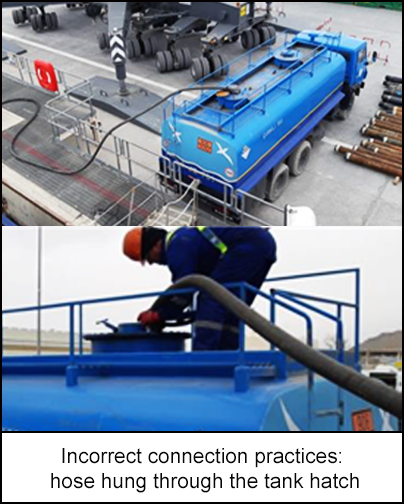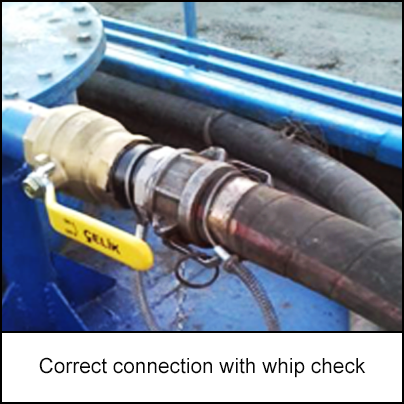-
What happened?
A vessel was quayside, having sewage transferred to a sewage truck.
The sewage transfer hose was hung through the hatch of the tank.
30-40 litres of sewage water spilled onto the quayside.
There was no discharge into the sea due to a contained concreted area on the quayside.

-
Why did it happen?
The correct hose connection was not available on the truck. The sewage transfer hose was hung through the hatch of the tank and secured by rope only.
The unsafe condition was neither reported nor challenged until after the spill had taken place.
The truck driver had no way to communicate to the vessel during the transfer, so there was a delayed response and shut down of the transfer pump on the vessel.
A wet bulk transfer checklist was not completed – workers failed to follow a company safety management system (SMS) requirement.

-
What did they learn?
Confirm that compatible hose connections and whip checks are available for all liquid waste trucks.
Confirm that all equipment used for sewage and oil water transfers is in good condition and certified in line with local regulations.
Provide radios or other communications equipment for use during transfer operations.
Ensure all workers complete the wet bulk transfer checklist for waste oil and sewage transfers.

-
Ask yourself or your crew
What is the correct way of transferring sewage from vessels to sewage trucks?
Do you have the correct equipment you need to perform your task? What should you do if not?
How do you communicate with other workers? Is there a more efficient way?
What is our emergency procedure for spills?

Add to homescreen
Content name
Select existing category:
Content name
New collection
Edit collection
What happened?
A vessel was quayside, having sewage transferred to a sewage truck.
The sewage transfer hose was hung through the hatch of the tank.
30-40 litres of sewage water spilled onto the quayside.
There was no discharge into the sea due to a contained concreted area on the quayside.

Why did it happen?
The correct hose connection was not available on the truck. The sewage transfer hose was hung through the hatch of the tank and secured by rope only.
The unsafe condition was neither reported nor challenged until after the spill had taken place.
The truck driver had no way to communicate to the vessel during the transfer, so there was a delayed response and shut down of the transfer pump on the vessel.
A wet bulk transfer checklist was not completed – workers failed to follow a company safety management system (SMS) requirement.
What did they learn?
Confirm that compatible hose connections and whip checks are available for all liquid waste trucks.
Confirm that all equipment used for sewage and oil water transfers is in good condition and certified in line with local regulations.
Provide radios or other communications equipment for use during transfer operations.
Ensure all workers complete the wet bulk transfer checklist for waste oil and sewage transfers.

Ask yourself or your crew
What is the correct way of transferring sewage from vessels to sewage trucks?
Do you have the correct equipment you need to perform your task? What should you do if not?
How do you communicate with other workers? Is there a more efficient way?
What is our emergency procedure for spills?
A vessel was quayside, having sewage transferred to a sewage truck. 30-40 litres of sewage water spilled onto the quayside.













